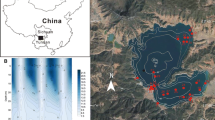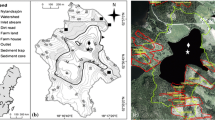Abstract
The seasonal sedimentation pattern of diatom valves in Lake Holzmaar was investigated during 1995 by deploying sediment traps at three different lake depths. According to the sedimentation pattern, the major reproduction zone of diatoms was restricted to the upper 6 m of the water body. The population growth started late in April and blooms of Cyclotella cf. comensis Grun., which dominates the plankton diatoms, and Fragilaria crotonensis Kitton were collected in traps during June and September, and July, respectively. During summer, the seasonal sedimentation pattern of each taxon, as collected in the upper traps, was reflected in the concentrations in the lowest trap. However, in May and from September onwards, the community composition in the lowest trap and augmented trapping rates suggest both sediment focusing and resuspension of bottom sediments.
The temperature signals as recorded by δ18O values of diatom valves should, therefore, reflect integrated temperatures between 0 and 6 m depth. However, temperatures during summer and autumn are expected to be accentuated in the sedimentary record since the isotopic signal is weighted by both the number and the weight-mass of the valves. During summer, the transfer of these signals by the sedimenting diatoms retains the information pattern recorded, while in spring and autumn/winter additional influxes caused by resuspension may somewhat alter those temperature informations. The proxy signals finally stored in the sediments, may, therefore, not precisely represent the successive temperatures currently recorded during 1995 within mid-lake.
Similar content being viewed by others
References
Barker, P., J.-C. Fontes, F. Gasse & J.-C. Druart, 1994. Experimental dissolution of diatom silica in concentrated salt solutions and implications for paleoenvironmental reconstruction. Limnol. Oceanogr. 39/1: 99–110.
Battarbee, R. W., 1986. Diatom analysis.-In: Berglund, B.E. (ed) Handbook of Holocene palaeoecology and palaeohydrology. Wiley & Sons, Chichester, 527–570.
Battarbee, R. W. & M. J. Kneen, 1982. The use of electronically counted microspheres in absolute diatom analysis. Limnol. Oceanogr. 27: 184–188.
Bengtsson, L., T. Hellström & L. Rakoczi, 1990. Redestribution of sediments in three Swedish lakes. Hyrobiologia 192: 167–181.
Bloesch, J., 1995. Mechansims, measurement and importance of sediment resuspension in lakes. Mar. Freshwater Res. 46: 295–304.
Bloesch, J. & N. M. Burns, 1980. A critical review of sedimentation trap technique. Schweiz. Z. Hydrol. 42/1: 15–55.
Blomqvist, S. & L. Håkanson, 1981. A review on sediment traps in aquatic environments. Arch. Hydrobiol. 91/1: 101–132.
Bradbury, J. P., 1988. A climatic-limnologic model of diatom sucession for paleolimnological interpretation of varved sediments at Elk Lake, Minnesota. J. Paleolimnol. 1: 115–131.
Brauer, A., 1994. Weichselzeitliche Seesedimente des Holzmaars-Warvenchronologie des Hochglazials und Nachweis von Klimaschwankungen. Documenta naturae 85, München, 210pp.
Burns, N. M. & F. Rosa, 1980. In situ measurement of the settling velocity of organic carbon particles and 10 species of phytoplankton. Limnol. Oceanogr. 25/5: 855–864.
Cameron, N. G., 1995. The representation of diatom communities by fossil assemblages in a small acid lake. J. Paleolimnol. 14: 185–223.
Charlton, M. N. & D. R. S. Lean, 1987. Sedimentation, resuspension, and oxygen depletion in Lake Erie (1979). J. Great Lakes Res. 13 (4): 709–723.
Davis, M. B., R. E. Moeller & J. Ford, 1984. Sediment focusing and pollen influx. In Haworth E. Y. & J. W. G. Lund, (eds) Lake sediments and environmental history. University of Minnesota Press, Minneapolis, 261–293.
Eadie, B. J., R. L. Chambers, W. S. Gardner & G. L. Bell, 1984. Sediment trap studies in Lake Michigan: Resuspension and chemical fluxes in the southern basin. J. Great Lakes Res. 10 (3): 307–321.
Fritz, S. C., S. Juggins, R. Battarbee & D. R. Engstrom, 1991. Reconstruction of past changes in salinity and climate using a diatom-based transfer function. Nature 352: 706–708.
Gálvez, J. A., F. X. Niell & J. Lucena, 1993. Sinking velocities of principal phytoplankton species in a stratified reservoir: Ecological implications. Verh. Internat. Verein. Limnol. 25: 1228–1231.
Håkanson, L., S. Floderus & M. Wallin, 1989. Sediment trap assemblages-a methodological description. Hydrobiol. 176/177: 481–490.
Hargrave, B. T. & N. M. Burns, 1979. Assessment of sediment trap collection efficiency. Limnol. Oceanogr. 24: 1124–1136.
Horn, H. & W. Horn, 1993. Sedimentary losses in the Reservoir Saidenbach: Flux and sinking velocities of dominant phytoplankton Species. Int. Revue ges. Hydrobiol. 78/1: 39–57.
Jahn, R., 1990. Untersuchungen zur benthischen Diatomeenflora und-vegetation der Spree und angrenzender Kanäle im innerstädtischen Gebiet von Berlin (West). PhD Thesis, FUBerlin, 255pp.
Krammer, H. & H. Lange-Bertalot, 1986–1991. Bacillariophyceae. In Ettl, H., G. Gärtner, J. Gerloff, H. Heynig & D. Mollenhauer (eds): Süßwasserflora von Mitteleuropa 2 (1–4). Gustav Fischer, Stuttgart.
Lücke, A., G.-H. Schleser & J. W. F. Negendank (1998). Variations of oxygen isotopes in the hydrologic system of Lake Holzmaar (Eifel, Germany)-implications for the palaeoclimatic interpretation of the sedimentary record. IAEA-SM-349/24.
Lund, J. W. G., 1950. Studies on Asterionella formosa Hass. II. Nutrient depletion and the spring maximum. J. Ecol. 38: 1–35.
Melzer, A., 1992. Submersed macrophytes. In Scharf, B. W. & S. Björk (eds): Limnology of Eifel maar lakes. Adv. Limnol. 38: 223–237.
Paasche, E., 1980. Silicon. In Morris, I., (ed). The physiological ecology of phytoplankton. Studies Ecol. 7: Oxford, 259–284.
Parker, J. I., H. L. Conway & E. M. Yaguchi, 1977. Dissolution of diatom frustules and recycling of amorphous silicon in Lake Michigan. J. Fish. Res. Board Can 34: 545–551.
Patrick, R., 1977. Ecology of freshwater diatoms-diatom communities. In Werner D. (ed): The biology of diatoms. Blackwell Scientific Publications, Oxford, 284–332.
Pienitz, R., J. P. Smol, & H. J. Birks, 1995. Assessment of freshwater diatoms as quantitative indicators of past climatic change in the Yukon and Nothwest Territories, Canada. J. Paleolimnol. 13: 21–49.
Reynolds, C. S., 1984. The ecology of freshwater phytoplankton. Cambridge University Press. Cambridge, 369pp.
Rippey, B., 1983. A laboratory study of the silicon release processes from a lake sediment (Lough Ness, Northern Ireland). Arch. Hydrobiol. 96/4: 417–433.
Rosa, F., J. Bloesch & D. E. Rathke, 1991. Sampling the settling and suspended particulate matter (SPM). In Mudroch, A. & S. D. MacKnight (eds): Handbook of Techniques for Aquatic Sediments Sampling, Florida, 97–130.
Scharf, B., & U. Menn, 1992. Hydrology and morphometry. In Scharf, B. W. & S. Björk (eds): Limnology of Eifel maar lakes. Adv. Limnol. 38: 43–62.
Sommer, U., 1984. Sedimentation of principal phytoplankton species in Lake Constance. J. Plankt. Res. 6/1: 1–14.
Sommer, U., 1988. Growth and survival strategies of planktonic diatoms. In Sandgren, C. D. (ed) Growth and reproductive strategies of freshwater phytoplankton. Cambridge.
Sommer, U. & H. H. Stabel, 1983. Silicon consumption and population density changes of dominant planktonic diatoms in Lake Constance. J. Ecol. 71: 119–130.
Sommer, U., Z. M. Gliwicz, W. Lampert & A. Duncan, 1986. The PEG-model of seasonal succession of planktonic events in fresh Waters.-Arch. Hydrobiol. 106/4: 433–471.
Tessenow, U., 1972. Lösungs-, Diffusions-und Sorptionsprozesse in der Oberschicht von Seesedimenten. Arch. Hydrobiol. Suppl. 38: 353–398.
Tilman, D., S. S. Kilham & P. Kilham, 1982. Phytoplankton community ecology: The role of limiting nutrients. Ann. Rev. Ecol. System. 13: 349–372.
Vyverman, W. & K. Sabbe, 1995. Diatom-temperature transfer functions based on the altitudinal zonation of diatom assemblages in Papua New Guinea: A possible tool in the reconstruction of regional palaeoclimatic changes. J. Paleolimnol. 13: 65–77.
Weckström, J., A. Korhola & T. Blom, 1997. The relationship between diatoms and water temperature in thirty subarctic fennoscandian lakes. Arc. Alp. Res. 29/1: 75–92.
Willén, E., 1991. Planktonic diatoms-an ecological review. Algological Studies 62: 69–106.
Zolitschka, B., 1991. Absolute dating of late-Quaternary lacustrine sediments by high resolution varve chronology. Hydrobiol. 214: 59–61
Zolitschka, B., 1996. Paläoklimatische Bedeutung laminierter Sedimente. Habilitationsschrift. Mathemat.-naturwissenschaftl. Fakultät der Universität Potsdam, Germany, 196pp.
Author information
Authors and Affiliations
Rights and permissions
About this article
Cite this article
Raubitschek, S., Lücke, A. & Schleser, G.H. Sedimentation patterns of diatoms in Lake Holzmaar, Germany - (on the transfer of climate signals to biogenic silica oxygen isotope proxies). Journal of Paleolimnology 21, 437–448 (1999). https://doi.org/10.1023/A:1008022532458
Issue Date:
DOI: https://doi.org/10.1023/A:1008022532458




